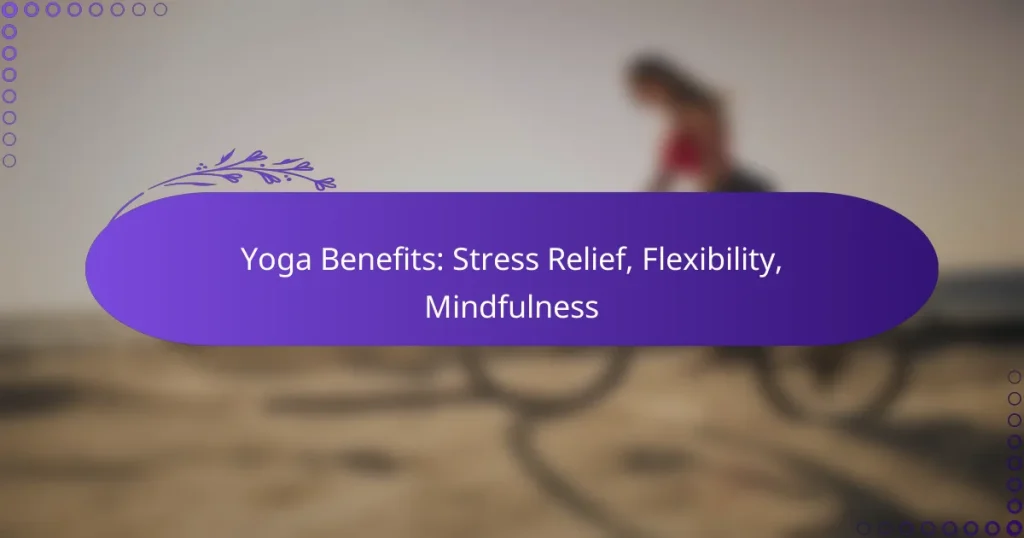Physical activity plays a crucial role in enhancing holistic wellness by positively impacting mental, physical, social, and emotional health. By incorporating regular exercise into daily routines, individuals can achieve a balanced lifestyle that promotes overall well-being and fosters resilience against stress.
Yoga Benefits: Stress Relief, Flexibility, Mindfulness
Movement in Workdays: Productivity, Health, Energy
Cardio vs Strength Training: Which Is Better and When to Use
Outdoor Activities: Mental Health, Connection, Stress Relief
Exercise Impact on Sleep: Quality, Duration, Improvement
Home Workouts: Flexibility, Strength, Time Efficiency
How does physical activity enhance holistic wellness?
Physical activity enhances holistic wellness by improving various aspects of an individual’s life, including mental, physical, social, and emotional health. Engaging in regular exercise fosters a balanced lifestyle that promotes overall well-being.
Improves mental health
Regular physical activity is linked to reduced symptoms of anxiety and depression. Exercise releases endorphins, which are natural mood lifters, helping to alleviate stress and improve overall mental clarity.
Incorporating activities like walking, jogging, or yoga into your routine can significantly enhance your mental resilience. Aim for at least 30 minutes of moderate exercise most days to experience these benefits.
Boosts physical health
Physical activity is essential for maintaining a healthy body. It strengthens the cardiovascular system, improves muscle tone, and enhances flexibility, contributing to overall physical fitness.
Engaging in a mix of aerobic and strength-training exercises can help manage weight, lower the risk of chronic diseases, and improve longevity. The CDC recommends at least 150 minutes of moderate-intensity aerobic activity each week for adults.
Enhances social connections
Participating in group exercises or team sports fosters social interaction, which is vital for emotional well-being. Building relationships through shared physical activities can create a sense of community and belonging.
Consider joining local fitness classes or sports leagues to expand your social network. These connections can provide motivation and support, making it easier to maintain an active lifestyle.
Promotes emotional balance
Physical activity can help regulate emotions by providing a constructive outlet for stress and frustration. Exercise encourages mindfulness and self-awareness, which are crucial for emotional stability.
To promote emotional balance, integrate activities such as tai chi or dance, which not only engage the body but also foster a connection between mind and spirit. Regular participation can lead to a more resilient emotional state.
What types of physical activities support holistic wellness?
Physical activities that support holistic wellness encompass a variety of practices aimed at enhancing mental, emotional, and physical health. Engaging in diverse forms of exercise not only improves fitness but also fosters a balanced lifestyle.
Yoga for mindfulness
Yoga is a powerful practice that promotes mindfulness through controlled breathing and focused movement. It encourages participants to connect with their bodies and minds, reducing stress and enhancing emotional well-being.
Incorporating different styles, such as Hatha or Vinyasa, can cater to various fitness levels and preferences. Practicing yoga regularly, even for short sessions, can significantly improve mental clarity and emotional stability.
Aerobic exercises for cardiovascular health
Aerobic exercises, such as running, cycling, or swimming, are essential for maintaining cardiovascular health. These activities elevate the heart rate, improving circulation and overall endurance.
Engaging in at least 150 minutes of moderate-intensity aerobic activity per week is recommended for adults. This can be broken down into manageable sessions, making it easier to fit into a busy lifestyle.
Strength training for muscle health
Strength training focuses on building muscle mass and improving overall strength, which is vital for functional fitness and injury prevention. This can include weightlifting, resistance bands, or bodyweight exercises.
Adults should aim for two or more days of strength training each week, targeting all major muscle groups. Gradually increasing weights or resistance can help avoid plateaus and promote continuous improvement.
Outdoor activities for nature connection
Outdoor activities, such as hiking, gardening, or team sports, foster a connection with nature while providing physical benefits. Spending time outside can enhance mood and reduce feelings of anxiety.
Participating in outdoor activities not only promotes physical fitness but also encourages social interaction and community engagement. Aim to incorporate outdoor time into your weekly routine for both physical and mental health benefits.
How can I integrate physical activity into my daily routine?
Integrating physical activity into your daily routine can be straightforward and rewarding. Focus on small, manageable changes that fit into your lifestyle, making it easier to stay active consistently.
Set achievable goals
Setting achievable goals is crucial for maintaining motivation. Start with specific, measurable objectives, such as walking 30 minutes a day or completing three workouts per week. Gradually increase the intensity or duration as you progress.
Consider using the SMART criteria—Specific, Measurable, Achievable, Relevant, and Time-bound—to guide your goal-setting process. This approach helps ensure your goals are realistic and attainable.
Incorporate movement breaks
Incorporating movement breaks throughout your day can significantly boost your physical activity levels. Aim for short breaks every hour to stretch, walk, or perform quick exercises like squats or lunges.
Even brief 5-10 minute breaks can enhance your energy and focus. Set reminders on your phone or use a timer to encourage regular movement during work or study sessions.
Join local fitness groups
Joining local fitness groups can provide both motivation and accountability. Look for community centers, gyms, or online platforms that offer group classes, running clubs, or sports teams.
Participating in group activities not only makes exercising more enjoyable but also helps you connect with others who share similar fitness goals. Check local listings or social media for opportunities in your area.
Utilize fitness apps like MyFitnessPal
Fitness apps like MyFitnessPal can help you track your physical activity and nutrition effectively. These apps often provide features for logging workouts, setting goals, and monitoring progress.
Using such tools can keep you accountable and motivated. Explore various apps to find one that suits your needs, whether you prefer tracking calories, workouts, or overall wellness.
What are the benefits of community-based wellness programs?
Community-based wellness programs offer numerous benefits, including access to professional guidance, social support, and structured activities that enhance overall health. These programs foster a sense of belonging while promoting physical activity and holistic wellness.
Access to professional guidance
Community wellness programs often include access to trained professionals such as fitness instructors, nutritionists, and mental health experts. This guidance helps participants set realistic goals and adopt effective strategies for improving their health.
For example, a local program might offer workshops led by certified trainers who can tailor exercise routines to individual needs, ensuring safety and effectiveness. This professional support can significantly enhance the likelihood of achieving wellness goals.
Social support and motivation
Engaging in wellness programs within a community provides essential social support, which can boost motivation and adherence to health goals. Participants often share experiences, challenges, and successes, creating a network of encouragement.
For instance, group workouts or health challenges can foster camaraderie, making physical activity more enjoyable and less isolating. This social aspect can be particularly beneficial for those who struggle with motivation when exercising alone.
Structured group activities
Community wellness programs typically offer structured group activities that promote regular physical engagement. These activities can range from group fitness classes to organized sports, catering to various interests and fitness levels.
Participating in scheduled sessions helps individuals build a routine, making it easier to incorporate physical activity into their daily lives. Additionally, the variety of activities available can keep participants engaged and excited about their fitness journey.
Improved accountability
Being part of a community wellness program enhances accountability among participants. When individuals commit to a group, they are more likely to follow through with their health goals due to the shared expectations and support from others.
For example, regular check-ins or progress tracking within the group can motivate members to stay on course. This accountability can be a powerful tool in overcoming obstacles and maintaining long-term wellness habits.
What criteria should I consider when choosing a wellness program?
When selecting a wellness program, consider factors such as accreditation, program content, and the qualifications of instructors. These elements ensure that the program is credible, effective, and tailored to your specific health goals.
Program accreditation
Program accreditation is a crucial factor in choosing a wellness program as it indicates that the program meets established standards of quality and effectiveness. Look for programs accredited by recognized organizations, which often require adherence to specific guidelines and best practices.
Accredited programs typically offer evidence-based approaches and are more likely to have qualified instructors. For example, a program accredited by the National Wellness Institute may provide assurance of its commitment to holistic health principles.
To verify accreditation, check the program’s website or contact the organization directly. Avoid programs that lack transparency about their accreditation status, as this may signal lower quality or unproven methods.






